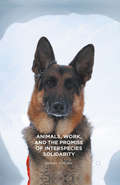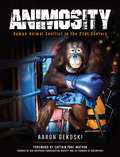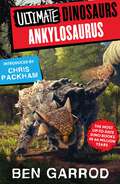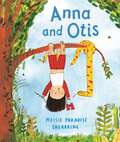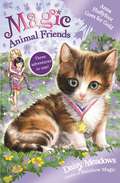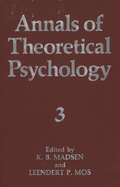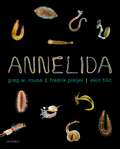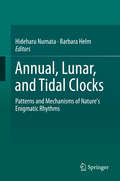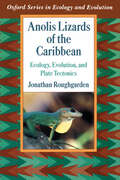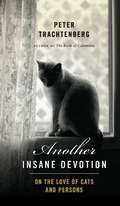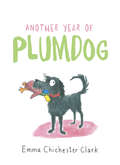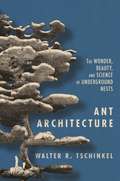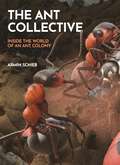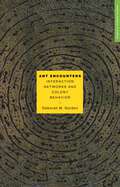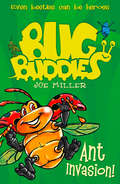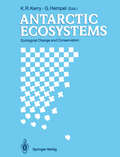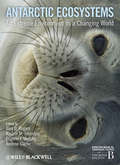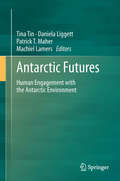- Table View
- List View
Animals, Work, and the Promise of Interspecies Solidarity
by Kendra CoulterIn this thought-provoking and innovative book, Kendra Coulter examines the diversity of work done with, by, and for animals. Interweaving human-animal studies, labor theories and research, and feminist political economy, Coulter develops a unique analysis of the accomplishments, complexities, problems, and possibilities of multispecies and interspecies labor. She fosters a nuanced, multi-faceted approach to labor that takes human and animal well-being seriously, and that challenges readers to not only think deeply and differently about animals and work, but to reflect on the potential for interspecies solidarity. The result is an engaging, expansive, and path-making text.
Animosity: Human-Animal Conflict in the 21st Century
by Aaron GekoskiThe world’s wildlife is in crisis.Globally, animals are being traded, hunted, poached, consumed and exploited to the point of extinction. This is their story, as told through the lens and eyes of Aaron ‘Bertie' Gekoski, an internationally acclaimed environmental photojournalist, who documents human-animal conflict in the most inhospitable places on Earth.ANIMOSITY is a collection of powerful photographs and absorbing tales from the frontline of conservation: from Cambodia’s dog-drowning dungeons and West Africa’s voodoo markets, to cruel Wildlife Tourism Attractions and the shadowy world of the exotic pet trade.Conflict, conservation, and the battle to coexist: ANIMOSITY is the story of our generation, our legacy.Numerous animal welfare NGOs have lent their backing to the book including Born Free Foundation, Four Paws, World Animal Protection, International Animal Rescue, PETA & Scubazoo, while world famous actresses Shannon Elizabeth and Amy Jackson have written moving testimonies for the book.The foreword has been written by one of the best-known environmental activists in the world, Captain Paul Watson, founder of the Sea Shepherd conservation society and a co-founder of Greenpeace.
Ankylosaurus (Ultimate Dinosaurs)
by Ben GarrodCovered in armoured plates and sharp spikes, weighing more than an elephant, and swinging a deadly tail club capable of smashing through bone, Ankylosaurus is an Ultimate Dinosaur. But one we know very little about. Why have so few of their skeletons been found? Could they really have used their tails to take down an attacking Tyrannosaurus rex? Find out about this indestructible dinosaur and 7 more in the Ultimate Dinosaurs series.Pop a dinosaur in your pocket! Introductions from Chris Packham, Steve Backshall and Dr Jane Goodall. These are the most up-to-date dino books in 66 million years, also available in audio download!TV scientist, Professor Ben Garrod, is proud to be a geek as he mixes top level science and humour to prove that science is for everyone. Looking at the evolutionary arms race, prey, predators, place, time, groups and species, Ben reveals new-look dinosaurs. Additional sections include: Ask an Expert, New Science and Fossil Finder as well as quizzes to test your dinosaur knowledge.'A celebration of everything that science is really about.' NatSCA'A perfect primer for kids to learn more about the amazing "terrible lizards".' BBC Wildlife Magazine'He's the man! The genius is his knowledge; the genius is the man himself!' Chris Evans, Virgin Radio Breakfast Show'Shines a fresh, contemporary light on this ever-popular topic.' The Bookseller'Collectable and eye-catching, with plenty of diagrams and illustrations.' Books for Keeps
Anna and Otis
by Maisie Paradise ShearringA hugely endearing, very funny story about kindness, friendship and overcoming fears, from award-winning illustrator Maisie Paradise Shearring.Anna and Otis the snake are great friends and they love having fun together. But Otis knows people are scared of snakes, so he usually just plays at home or in the garden. He is nervous when Anna suggests a new adventure. At first people are afraid, and Otis feels he isn't welcome in the town. But Anna encourages Otis not to give up, and it soon turns out that maybe snakes aren't as scary as people thought! The hairdresser enjoys shampooing a reptile for a change, and at the skate shop Sally has a lot of fun fitting Otis with his own set of awesome wheels. Anna and Otis is full of endless rich details to spot and Maisie's artwork is a treat to pore over.
Anna Fluffyfoot Goes for Gold: Special 6 (Magic Animal Friends #6)
by Daisy MeadowsAn enchanting series full of adorable animals, magic and friendship - from the creator of RAINBOW MAGIC, the UK's bestselling series for girls aged 5-7.In the magical land of Friendship Forest, the animals are getting ready for a sports day! But wicked Grizelda wants to spoil everyone's fun. Can best friends Lily and Jess help super-cute kitten Anna Fluffyfoot stop the witch's horrible plans, before the special day is ruined?
Annals of Theoretical Psychology: Volume 3
by K. B. Madsen Leendert P. MosAs a follow up to Volume 7, contributors continue to explore the latest developments in developmental psychology. Here, researchers focus on the integration of theory and research and evaluates theoretical progress and advanced research. Continuing with the successful format of previous volumes in Annals of Theoretical Psychology, Volume 10 presents four major contributions--each accompanied by commentaries and replies to commentaries.
Annelida
by Greg Rouse Fredrik Pleijel Ekin TilicAnnelids (the segmented worms) exist in a remarkably diverse range of mostly marine but also freshwater and terrestrial habitats, varying greatly in size and form. Annelida provides a fully updated and expanded taxonomic reference work which broadens the scope of the classic Polychaetes (OUP, 2001) to encompass wider groups including Clitellata (comprising more than a third of total annelid diversity), Sipuncula, and Thalassematidae (formerly Echiura). It reflects the enormous amount of research on these organisms that has burgeoned since the millennium, principally due to their use as model organisms to address wider and more general evolutionary and ecological questions. Beginning with a clear introduction to the phylum and an outline of annelid taxonomy, this authoritative text describes their collection, the methods to ensure their optimal preservation, and an overview of anatomy with its relevant terminology. The core of the work comprises 77 fully up-to-date taxonomic chapters, informed by anatomy and the latest molecular phylogenomic evidence and carefully organised based on a new, robust phylogenetic hypothesis. Lavishly illustrated throughout with hundreds of previously unpublished high-resolution colour images and SEM micrographs, the sheer beauty and diversity of the annelids is nowhere better presented. Annelida is the definitive reference work for annelid biologists, whilst being of interest to a broader audience of invertebrate zoologists, systematists, and organismal biologists.
Annual, Lunar, and Tidal Clocks: Patterns and Mechanisms of Nature's Enigmatic Rhythms
by Hideharu Numata Barbara HelmThere is more to biological rhythms than circadian clocks. This book aims at promoting the exciting potential of a deeper understanding of circannual, circatidal, and circalunar clocks. It highlights new developments, summarizes existing knowledge, and integrates different perspectives with the tools and ideas of diverse fields of current biology.For predominantly pragmatic reasons, research in recent decades was mostly concerned with circadian clocks. Clocks on other timescales, however, have been largely neglected and therefore still appear "enigmatic". Thanks to the rapid development of methods in molecular biology as well as in ecology, we are now able to re-approach these clocks. Laboratories around the world are showing fresh interest and substantial progress is being made in many independent projects. The book's two sections address the moon-derived circatidal, circasemilunar, and lunar cycles on the one hand (10 chapters), and the sun-derived circannual cycles on the other (6 chapters). This work brings together authors with an expansive array of expertise and study systems, ranging from tidal cycles of marine invertebrates to annual cycles of birds and mammals, and from behavioral to genetic and epigenetic backgrounds. While great challenges remain to be mastered, the book aims at conveying the excitement of unraveling, broadly, the rhythms of life.
Anolis Lizards of the Caribbean: Ecology, Evolution, and Plate Tectonics (Oxford Series in Ecology and Evolution)
by Jonathan RoughgardenThe Anolis lizards of the Caribbean are ideally suited for the study of evolutionary ecology. Offering fascinating insights into the more than 150 species dispersed throughout the Caribbean islands, Jonathan Roughgarden details the differences between species in a wide range of behavioral and physical characteristics, including foraging behaviors, body size, and habitat use, resulting from evolutionary divergences concurrent with the plate-tectonic origins of the region. This book will be of interest to students and researchers--ecology and theoretical, tropical, and population biology.
Another Insane Devotion: On the Love of Cats and Persons
by Peter TrachtenbergFrom &“a genuine American Dostoevsky&” (The Washington Post): a dazzling, funny, bittersweet exploration of the mysteries of relationship, both human and animal.When his favorite cat Biscuit goes missing, Peter Trachtenberg sets out to find her. The journey takes him 700 miles and many years into his past-- into the history of his relationships with cats and the history of his relationship with his wife F., who may herself be on the verge of disappearing. What ensues is a work that recalls travel narratives from The Incredible Journey to W. G. Sebald&’s The Rings of Saturn. Trachtenberg ponders the mysteries of feline intelligence (why do cats score worse on some tests than pigeons?), the origins of their domestication, their terrible treatment during the Middle Ages. He also looks at the riddle of why any of us loves whom we love and all the unforeseen places to which that devotion leads us.
Another Year of Plumdog
by Emma Chichester ClarkIn 2014 Cape published Plumdog, a year’s worth of entries from Emma Chichester Clark’s blog of the same name which records the daily life of Plum, her dog, in Plum’s own words and Emma’s delightful illustrations. It was seized on by dog lovers everywhere and became the bestselling book written by a dog of that year … indeed quite possibly since records began.Another Year of Plumdog is exactly what it says: another year of leaping, catching balls, diving into rivers, puddles, the North Sea, and hanging out with friends.
Ant and Bee: An Alphabetical Story For Tiny Tots (Ant and Bee)
by Angela BannerThese were the books that taught me how to read' Anthony Horowitz.
Ant and Bee and the ABC (Ant and Bee)
by Angela BannerThe much-loved classic series of Ant and Bee books is designed for shared reading fun! First published in 1950, Ant and Bee were in print for over 40 years. These new editions feature revised text and illustrations by original Ant and Bee creator Angela Banner. The adorably small format is perfect for little hands.
Ant and Bee and the Doctor (Ant and Bee)
by Angela BannerThe much-loved classic series of Ant and Bee books is designed for shared reading fun! First published in 1950, Ant and Bee were in print for over 40 years. These new editions feature revised text and illustrations by original Ant and Bee creator Angela Banner. The adorably small format is perfect for little hands.
Ant Architecture: The Wonder, Beauty, and Science of Underground Nests
by Walter R. TschinkelAn unprecedented look at the complex and beautiful world of underground ant architectureWalter Tschinkel has spent much of his career investigating the hidden subterranean realm of ant nests. This wonderfully illustrated book takes you inside an unseen world where thousands of ants build intricate homes in the soil beneath our feet.Tschinkel describes the ingenious methods he has devised to study ant nests, showing how he fills a nest with plaster, molten metal, or wax and painstakingly excavates the cast. He guides you through living ant nests chamber by chamber, revealing how nests are created and how colonies function. How does nest architecture vary across species? Do ants have "architectural plans"? How do nests affect our environment? As he delves into these and other questions, Tschinkel provides a one-of-a-kind natural history of the planet's most successful creatures and a compelling firsthand account of a life of scientific discovery.Offering a unique look at how simple methods can lead to pioneering science, Ant Architecture addresses the unsolved mysteries of underground ant nests while charting new directions for tomorrow’s research, and reflects on the role of beauty in nature and the joys of shoestring science.
Ant Architecture: The Wonder, Beauty, and Science of Underground Nests
by Walter R. TschinkelAn unprecedented look at the complex and beautiful world of underground ant architectureWalter Tschinkel has spent much of his career investigating the hidden subterranean realm of ant nests. This wonderfully illustrated book takes you inside an unseen world where thousands of ants build intricate homes in the soil beneath our feet.Tschinkel describes the ingenious methods he has devised to study ant nests, showing how he fills a nest with plaster, molten metal, or wax and painstakingly excavates the cast. He guides you through living ant nests chamber by chamber, revealing how nests are created and how colonies function. How does nest architecture vary across species? Do ants have "architectural plans"? How do nests affect our environment? As he delves into these and other questions, Tschinkel provides a one-of-a-kind natural history of the planet's most successful creatures and a compelling firsthand account of a life of scientific discovery.Offering a unique look at how simple methods can lead to pioneering science, Ant Architecture addresses the unsolved mysteries of underground ant nests while charting new directions for tomorrow’s research, and reflects on the role of beauty in nature and the joys of shoestring science.
The Ant Collective: Inside the World of an Ant Colony
by Armin SchiebAnts come alive on this fabulously illustrated journey into the heart of a bustling colonyAnts share a vibrant and complex communal life and remarkable abilities to communicate with each other. The Ant Collective presents the world of ants as you have never seen it before, using hyperrealistic, computer-generated imagery that shows 3D-like views of activities inside and outside a thriving nest of red wood ants. With chapters on topics ranging from the establishment and construction of the nest to the birth of an ant trail and the relocation of a colony, this one-of-a-kind book brilliantly integrates informative descriptions with the illustrations, drawing on the latest science to reveal the innermost workings of the colony and enabling you to explore the ant collective as if you are there.Features a wealth of naturalistic 3D-like illustrations and schematic infographicsDepicts the anatomy of ants, the architecture of their nests, their interactions with the environment and other animals, and their collective social behaviorFollows the annual life cycle of the colonyProvides an incredible up-close look at ant reproduction, defense, foraging, nesting, division of labor, and morePacked with information about the biology, ecology, and communication skills of these marvelous insects
Ant Encounters: Interaction Networks and Colony Behavior
by Deborah M. GordonHow do ant colonies get anything done, when no one is in charge? An ant colony operates without a central control or hierarchy, and no ant directs another. Instead, ants decide what to do based on the rate, rhythm, and pattern of individual encounters and interactions--resulting in a dynamic network that coordinates the functions of the colony. Ant Encounters provides a revealing and accessible look into ant behavior from this complex systems perspective. Focusing on the moment-to-moment behavior of ant colonies, Deborah Gordon investigates the role of interaction networks in regulating colony behavior and relations among ant colonies. She shows how ant behavior within and between colonies arises from local interactions of individuals, and how interaction networks develop as a colony grows older and larger. The more rapidly ants react to their encounters, the more sensitively the entire colony responds to changing conditions. Gordon explores whether such reactive networks help a colony to survive and reproduce, how natural selection shapes colony networks, and how these structures compare to other analogous complex systems. Ant Encounters sheds light on the organizational behavior, ecology, and evolution of these diverse and ubiquitous social insects.
Ant Encounters: Interaction Networks and Colony Behavior (PDF)
by Deborah M. GordonHow do ant colonies get anything done, when no one is in charge? An ant colony operates without a central control or hierarchy, and no ant directs another. Instead, ants decide what to do based on the rate, rhythm, and pattern of individual encounters and interactions--resulting in a dynamic network that coordinates the functions of the colony. Ant Encounters provides a revealing and accessible look into ant behavior from this complex systems perspective. Focusing on the moment-to-moment behavior of ant colonies, Deborah Gordon investigates the role of interaction networks in regulating colony behavior and relations among ant colonies. She shows how ant behavior within and between colonies arises from local interactions of individuals, and how interaction networks develop as a colony grows older and larger. The more rapidly ants react to their encounters, the more sensitively the entire colony responds to changing conditions. Gordon explores whether such reactive networks help a colony to survive and reproduce, how natural selection shapes colony networks, and how these structures compare to other analogous complex systems. Ant Encounters sheds light on the organizational behavior, ecology, and evolution of these diverse and ubiquitous social insects.
Ant Invasion (Bug Buddies #3)
by Joe MillerEven bugs can be heroes! Join the Bug Buddies on bug-tastic adventures, as they pit their wits against the dreaded spider Spinner, creepiest of all creepy crawlies…
Antarctic Ecosystems: Ecological Change and Conservation
by K. R. Kerry G. HempelAntarctic Ecosystems comprises 55 papers presented at the Fifth Symposium on Antarctic Biology held under the auspices of the Scientific Committee on Antarctic Research (SCAR) in Hobart, Australia, 29 August - 3 September, 1988. Both short- and long-term changes in ecosystems and community structures caused by natural and human factors were discussed to help understand the ecological processes taking place in a changing environment. The variability of ecological factors must be known for the development of realistic monitoring strategies and sound conservation practices.
Antarctic Ecosystems: An Extreme Environment in a Changing World
by Alex D. Rogers Nadine M. Johnston Eugene J. Murphy Andrew ClarkeSince its discovery Antarctica has held a deep fascination for biologists. Extreme environmental conditions, seasonality and isolation have lead to some of the most striking examples of natural selection and adaptation on Earth. Paradoxically, some of these adaptations may pose constraints on the ability of the Antarctic biota to respond to climate change. Parts of Antarctica are showing some of the largest changes in temperature and other environmental conditions in the world. In this volume, published in association with the Royal Society, leading polar scientists present a synthesis of the latest research on the biological systems in Antarctica, covering organisms from microbes to vertebrate higher predators. This book comes at a time when new technologies and approaches allow the implications of climate change and other direct human impacts on Antarctica to be viewed at a range of scales; across entire regions, whole ecosystems and down to the level of species and variation within their genomes. Chapters address both Antarctic terrestrial and marine ecosystems, and the scientific and management challenges of the future are explored.
Antarctic Ecosystems: An Extreme Environment in a Changing World
by Alex D. Rogers Nadine M. Johnston Eugene J. Murphy Andrew ClarkeSince its discovery Antarctica has held a deep fascination for biologists. Extreme environmental conditions, seasonality and isolation have lead to some of the most striking examples of natural selection and adaptation on Earth. Paradoxically, some of these adaptations may pose constraints on the ability of the Antarctic biota to respond to climate change. Parts of Antarctica are showing some of the largest changes in temperature and other environmental conditions in the world. In this volume, published in association with the Royal Society, leading polar scientists present a synthesis of the latest research on the biological systems in Antarctica, covering organisms from microbes to vertebrate higher predators. This book comes at a time when new technologies and approaches allow the implications of climate change and other direct human impacts on Antarctica to be viewed at a range of scales; across entire regions, whole ecosystems and down to the level of species and variation within their genomes. Chapters address both Antarctic terrestrial and marine ecosystems, and the scientific and management challenges of the future are explored.
Antarctic Futures: Human Engagement with the Antarctic Environment
by Tina Tin Daniela Liggett Patrick T Maher Machiel LamersAt the beginning of the 21st century, Antarctica is poised at the edge of a warmer and busier world. Leading Antarctic researchers examine the needs and challenges of Antarctic environmental management today and tomorrow. Through: (i) investigating the impacts of human activities on specific ecosystems and species, (ii) examining existing environmental management and monitoring practices in place in various regions and (iii) interrogating stakeholders, they address the following questions: What future will Business-As-Usual bring to the Antarctic environment? Will a Business-As-Usual future be compatible with the objectives set out under the Antarctic Treaty, especially its Protocol on Environmental Protection? What actions are necessary to bring about alternative futures for the next 50 years? This volume is an outcome of the International Polar Year (2007-2009) Oslo Science Conference (8-12, June, 2010).
